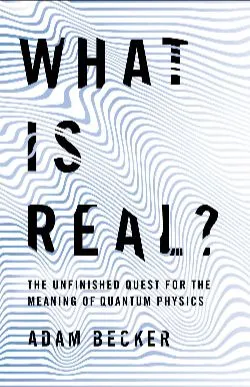
This is one of those books that I feel like I can only talk about with people who are as crazy as I am. In spite of the madness of its contents, this is a serious, learned, and thoughtful book.
Adam Becker begins the work with the Copenhagen Interpretation of quantum mechanics. Essentially, the Copenhagen Interpretation argues that quantum objects (electrons, photons, and so on) do not exist in a given location until they are observed. Before that, there is a wave function that tells an object’s probability of being in a place, but not itself. Yet, it also claims that quantum objects are the stuff that make up classical objects: everything ranging from a hydrogen molecule to the Sun. Weirder still, many adherents of the Copenhagen Interpretation go further and argue that quantum objects do not really exist at all. They are merely mathematical abstractions. Huh. How odd. How can classical objects be made of that which does not exist? Furthermore, it is unclear where the dividing line between quantum and classical objects is located.
What does all of this mean for us? And what does it mean to measure something? From the beginning, something didn’t sit right. For one, there is the measurement problem. If wave function collapse can only occur through observation, the line between quantum and macroscopic objects is being crossed. At the same time, the properties within quantum objects seem to require nonlocality. In Newtonian mechanics, objects function like a billiard ball table. They bounce off one another, and don’t move unless they do so (inertia, etc.). In quantum mechanics, this is violated, and particles can be modified from great distances–further than light speed would allow.
None of this makes sense with what we know about the universe! But, Niels Bohr and his followers argued that quantum theory was complete, until they day that they all died.
Becker’s book ultimately deals with the life cycle of the Copenhagen Interpretation, especially in relation to challenges to it. Becker tells us near the end that the Copenhagen Interpretation remains the dominant theory in quantum mechanics, but it is far from the only one. The first real challenge to quantum theory was launched by Albert Einstein himself. In addition, we now have pilot wave theory, the many-worlds interpretation, and a handful of others. Spontaneous-collapse theory, on the other hand, has a posed a challenge to quantum theory as a whole.
What makes the book so interesting is Becker’s argument that the Copenhagen Interpretation’s domination of the field isn’t due to “science” as traditionally construed, not really, at least. For one, the Copenhagen Interpretation emerged while logical positivism was in vogue, and it spoke to the philosophical moment. David Bohm was ostracized for his political views, spent years exiled in Brazil, and was pushed out by Bohr’s circle of friends. Hugh Everett saw his advances as a sort of game, and much preferred a high paying job within the Cold War military-industrial complex. John Stewart Bell acts as a sort of unsung hero, and it was he who really poked holes in John von Neumann’s theory. Bell’s work, in Becker’s reading, is what broke the dam and allowed theoretical pluralism into quantum mechanics.
It’s hard to avoid the impression that Niels Bohr is the “villain” of this narrative. Bohr was wicked smart, apparently charismatic, and his students worshiped him. Reading Becker’s book, I’ve come away with the impression that his students thought he could do no wrong. At the same time, he was self-protective, a bit narrow minded, and painfully obtuse. His students managed to gatekeep the field in the following generation, to the detriment of physics as a whole.
Becker elegantly depicts the ways social, political, and philosophical concerns had as much influence on the development of quantum theory as intellect.
Even so, it’s a wonder that the Copenhagen Interpretation remains dominant in quantum theory. Becker’s argues that this is simply because it works: philosophers of physics are at odds with physicists themselves on this front. Sure, it may function well mathematically, and it gets the job done, but it is also an incoherent theory that prevents the sort of “paradigm shifts” that may be needed for the rest of the field to click into place. That is to say, it works for now, but there may well be more effective, efficient ways of advancing research if we were able to think about it differently.
Fascinating stuff, and some of the content in here blew my mind. I’m so glad I read it.